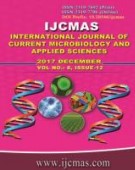


 National Academy of Agricultural Sciences (NAAS)
National Academy of Agricultural Sciences (NAAS)

|
PRINT ISSN : 2319-7692
Online ISSN : 2319-7706 Issues : 12 per year Publisher : Excellent Publishers Email : editorijcmas@gmail.com / submit@ijcmas.com Editor-in-chief: Dr.M.Prakash Index Copernicus ICV 2018: 95.39 NAAS RATING 2020: 5.38 |
The objective of this study was to evaluate growth of Aspergillus niger UCP 1353 isolated from Caatinga soil of Pernambuco (PE, Brazil), evaluating his development in the carbon (glucose and agro whey residue) and nitrogen (peptone and glutamic acid) sources to biomass production. To qualify discoloration Orange II from the adsorption process, the inactivated biomass of different concentrations (0.1 to 0.5g) were added to the dye for 24 h at 150 rpm and 30° C tests in comparison with activate charcoal. The most biomass production 94.1 g L-1 was occurred using whey, peptone and glutamic acid (15ml: 10g: 1g.L-1). The dye discoloration results showed a rate of 66% for 0.5g.L-1 of biomass concentration in contact 8h, and the greater adsorption capacity of 2.26 mg.g-1 to 0.1g.L-1 biomass for 24h. However, the comparison with the charcoal showed greater discolouration efficiency (100%) in contact of 8h. Thus, the experimental data for the adsorption Orange II dye, shown that the activate carbon has a more efficient removal compared to the fungal biomass. Despite these results, the use of fungal biomass in wastewater treatment processes can be made possible considering the reduction of the costs of production using agro-industrial waste.
 |
 |
 |
 |
 |